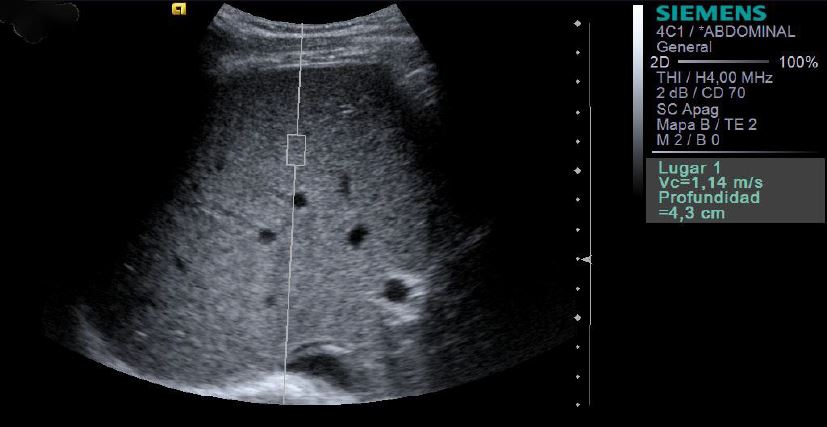TRASPLANTE HEPÁTICO:
INFLUENCIA DEL TIEMPO DE ISQUEMIA Y LA EDAD DEL DONANTE EN LA RIGIDEZ DEL INJERTO MEDIDA MEDIANTE ELASTOGRAFÍA TIPO ARFI
Palabras clave:
TRASPLANTE HEPÁTICO, TH, POSTER, SERAM, RIGIDEZ DEL INJERTO, ARFIResumen
OBJETIVO
El trasplante hepático (TH) se ha convertido en el tratamiento de elección en pacientes con fallo hepático crónico en fase terminal o agudo de diversas etiologías que no ha respondido a otros tratamientos y en casos seleccionados de hepatocarcinoma (HCC) que cumplan criterios clínicos
Los avances en la preservación del injerto, la aparición de nuevos inmunosupresores y la creación de unidades multidisciplinares especializadas en el seguimiento de los pacientes trasplantados hepáticos, han mejorado de forma significativa el pronóstico con una supervivencia del injerto.
MATERIAL Y MÉTODO
Se realizó un estudio longitudinal prospectivo desde septiembre de 2012 a junio de 2016 en el que se estudiaron 60 pacientes trasplantados hepáticos
consecutivos en el Hospital Universitario Puerta de Hierro Majadahonda
El comité ético del hospital consideró que los planteamientos del estudio eran correctos y que no suponían perjuicio alguno para el paciente ni cambio significativo en su seguimiento y dio su aprobación para realizarlo
Todos los pacientes fueron informados y dieron su consentimiento
Se recogieron los datos del donante edad, sexo y el tiempo de isquemia del injerto.
Descargas
Citas
Muiesan P, Girlanda R, Jassem W, Melendez HV, O’Grady J, Bowles M, et al Single center experience with liver transplantation from controlled non heartbeating donors a viable source of grafts Ann Surg noviembre de 2005;242(5):732-8
Chedid MF, Rosen CB, Nyberg SL, Heimbach JK Excellent long term patient and graft survival are possible with appropriate use of livers from deceased septuagenarian and octogenarian donors HPB septiembre de 2014;16(9):852-8
Girometti R, Como G, Bazzocchi M, Zuiani C Post operative imaging in liver transplantation state of the art and future perspectives World J Gastroenterol 28
de mayo de 2014;20(20):6180-200
Alegre F, Herrero JI, Iñarrairaegui M, Gavira JJ, Pujol C, Montero A, et al Increased liver stiffness values in patients with heart failure Acta Gastro Enterol Belg junio de 2013;76(2):246-50
Pfeifer L, Strobel D, Neurath MF, Wildner D Liver stiffness assessed by acoustic radiation force impulse ( technology is considerably increased in patients with cholestasis Ultraschall Med Stuttg Ger 1980 agosto de 2014;35(4):364-7
Kuroda H, Kakisaka K, Oikawa T, Onodera M, Miyamoto Y, Sawara K, et al Liver stiffness measured by acoustic radiation force impulse elastography reflects the
severity of liver damage and prognosis in patients with acute liver failure Hepatol Res Off J Jpn Soc Hepatol mayo de 2015;45(5):571-7
Zykus R, Jonaitis L, Petrenkienė V, Pranculis A, Kupčinskas L Liver and spleen transient elastography predicts portal hypertension in patients with chronic liver
disease a prospective cohort study BMC Gastroenterol 24 de diciembre de 2015;15:183
Carrión JA, Torres F, Crespo G, Miquel R, García Valdecasas J C, Navasa M, et al Liver stiffness identifies two different patterns of fibrosis progression in patients
with hepatitis C virus recurrence after liver transplantation Hepatol Baltim Md enero de 2010;51(1):23-34
Berge E, Otón E, Reina Z, Díaz L, Márquez A, Cejas L, et al Predictors of Poor Prognosis in Recurrent Hepatitis C After Liver Transplantation Transplant Proc noviembre de 2016;48(9):2997-9
Ijichi H, Shirabe K, Matsumoto Y, Yoshizumi T, Ikegami T, Kayashima H, et al Evaluation of graft stiffness using acoustic radiation force impulse imaging after
living donor liver transplantation Clin Transplant noviembre de 2014;28(11):1256-62


